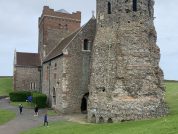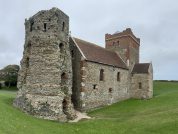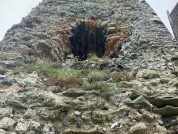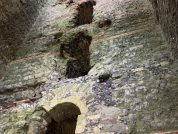During the Roman occupation of Britain Dover was a port called Dubris, or Portus Dubris and Dubrae. The name comes from the, the British word DUBRAS meaning ‘waters’. Little is known about the Roman use of the Dour estuary until the second half of the first century AD when a Roman settlement seems to have been established on the western bank and a harbour established, probably in the latter part of the first century. The impetus for the development of a port at Dover may have been the presence of the Roman port at Boulogne which lay on the opposite side of the channel and provided an easy link between the new province and the continent.
Classis Britannica fort at Dover
The Roman fleet in British waters, the Classis Britannica’s main purpose was protecting the Gaul-to-Britain routes and supporting the land army in Britannia. While its main base was in Gesoriacum (Boulogne), in the first half of the second century AD, it did have a base here in Dover and also at Rutupiae (Richborough Castle).
First Classis Britannica fort at Dover
As its base it built a large fort, covering more than two acres, on a shoulder of land below the Western Heights on the west bank of the Dour. In about AD 115-120 the fort, consisting of a wall and at least three barrack blocks was laid out, but was not been completed.
Second Classis Britannica fort at Dover
A second fort was built about AD 130-140 on a similar alignment, and this fort was completed. The army style fort was surrounded by a defensive wall and contained a headquarters building, at least two granaries and barracks. The buildings were separated from each other by wide metalled roads, along which ran drains and piped water.
Dover’s Saxon Shore Fort
Towards the end of the third century AD the ever increasing Saxon raids, necessitated the strengthening of the coastal defences. Around AD 270, Roman army units moved into Dover to construct a new “Fort of the Saxon Shore”. They ignored the old Classis Britannica Fort and built anew, although the corners of the two forts did overlap. The new fort enclosed a number of civilian buildings to the north of the earlier fort and the west wall went straight through the west end of the Painted House.
Over 1000 feet of the south and west wall of the fort have been traced. The massive defensive wall was nearly 10 feet thick, reinforced at intervals along its length by great stone bastions and a ditch nearly 40 feet wide and 10 feet deep. Within the walls have been found the remains of at least 11 timber built structures, metalled roads and a postern gate with footbridge. It also appears that the military bath-house dating from about AD 140-160 was reused within the walls of the fort which now enclosed it.
The fort seems to have been occupied at least until the first half of the 5th century and there is some evidence of occupation into the 6th century.
Roman Pharos at Dover
The Roman pharos or lighthouse at Dover was probably built in the first century A.D. A similar lighthouse was built on the Western Heights and at night guided Roman ships into the port of Dubris. The tower was octagonal outside and rectangular inside rising to a height of perhaps 80 feet (24m). It had eight storeys each set back 1 foot (0.3m) from the one below, which gave the whole structure the appearance of an extended telescope.
Only the first four Roman storeys remain, the present topmost storey being a fifteenth century reconstruction. The present splayed shape of the pharos is a result of the severe weathering it suffers in exposed position and mediaeval refacing.
Dover Vicus
To the north of the fort was an extensive civilian settlement containing many substantial buildings, including the Roman Painted House (built around AD 200) and a military bath-house (built around AD 140-160). Early in the third century AD the Classis Britannica left Dover, never to return. The fort was abandoned and soil accumulated over the remains until the building of the Saxon Shore Fort.
Roman Painted House
The excavations of 1971 and 1972 revealed parts of the south and west ranges of a substantial house, built of bricks and flint and consisting of at least six rooms, believed to have been constructed around AD 200. The rooms had floors of red mortar and the larger rooms had an under-floor heating system, or hypocaust. The internal walls of all the rooms had brightly coloured wall paintings on their plaster walls. It is the survival of these wall paintings that makes the house so remarkable, they are the best preserved in Britain, or almost anywhere outside Rome or Pompeii. The house may have been part of a mansio, an inn or guesthouse for travellers.
It was the fate of the house which led to survival of the paintings. When the Roman Army came to build the Saxon Shore Fort around AD 270 the house lay on the line of the western wall of the fort. The military engineers simply smashed through the west end of the house and built the great stone wall of the fort right across it from north to south. The back wall of the fort was then covered by a high bank of clay and rubble to form a rampart bank. It was this quick demolition and burial of the wall paintings, while still in good condition, which led to their survival.
The Roman Painted House is now displayed in a purpose built building just off the Market Square.
Classical References to Roman Dover
Portus Dubris appears as one of the termini of the third route in the British section of the Antonine Itinerary of the late-second century. Iter III is entitled “the route from Londinium to Portus Dubris – sixty-six thousand paces”, and places Portum Dubris 13 miles away from Durovernum (Canterbury, Kent).
Dover is next mentioned in the Notitia Dignitatum of the late-fourth century. Under the heading “at the disposal of the respectable man, the Count of the Saxon shore in Britain”, the entry Dubris is listed between the entries for Othona (Bradwell, Essex) and Portus Lemanis (Lympne, Kent).
The final mention of the Roman port occurs in the Ravenna Cosmology (R&C#71) of the seventh century, which lists the name Dubris between the entries for Portus Lemanis (Lympne, Kent) and Durovernum Cantiacorum (Canterbury, Kent).
Dover Kent. Dubris 4th cent., Dofras c.700, Dovere 1086 ( DB ). Named from the stream here, now called the Dour, a river-name (Welsh/Gaelic) *dubras meaning simply ‘the waters’.” (Mills)
Epigraphic Evidence from Roman Dover – Portus Dubris
RIB 3031 - Altar to the Matres Italicus
Olus Cornelius Candidus, governor’s equerry, built (this) shrine to the Mother Goddesses of Italy he paid his vow, [gladly, willingly, deservedly].
OL ▸ COR[...]
CANDID ▸ [...]
RÍ¡IÍ¡B TALIC[...]
AEDEM [...]
CIT ▸ V S [...]
The practice is more common elsewhere, but in Britain it is rare for dedications to name the dedicator before the deity; the other instances are RIB 140 (Bath, civis Trever), 652 (York, matres domesticae), 1057 (South Shields, a centurion possibly from Gaul), 3332 (Vindolanda, cives Galli) and 3489 (perhaps Risingham), two of them explicitly dedicated by incomers. It is also unusual for the dedicator’s rank to precede his name. 1. st(rator) co[(n)s(ularis)]. The evidence is epigraphic and says almost nothing of their duties: references are collected by Jones 1949, 44 n. 69, and by Speidel 1974. Like beneficiarii consularis, stratores consularis were legionaries seconded to the governor’s staff, and the literal translation ‘groom’ understates their responsibilities. It may be conjectured that they carried out special duties including the supervision of the cursus publicus: Dover was the port of entry for Iter III of the Antonine Itinerary (473, 1–2, a Londinio ad portum Dubris), and the possible station of another strator consularis (see RIB 3034). Only one other is attested in Britain, by his tombstone at Irchester (RIB 233), but compare Tab. Vindol. II, 310, addressed to Veldedeius equisio consularis. 2. Ol(us) is an alternative form of the praenomen Aulus; see for example CIL iv 2353+add., Aulus Olo suo salutem (quoted by Väänänen 1981, 39). The nomen Cordius is very rare, and in this much abbreviated text Cornel(ius), a frequent nomen, is much more likely. 3. The last surviving letter in 3 is represented by a serif so it cannot be a curved letter nor, on spacing, the letter A. M is only one of several possibilities, but is guaranteed as the first letter of [MAT] by (I)TALICIS in 4. For other British dedications to the Italian (and other) Mother Goddesses, see RIB 88 (Winchester, by a beneficiarius consularis) and 653 (York, by a legionary gubernator). 4. The first I of ITALICIS does double duty as the I (ligatured to R and B) of RIB. This was hardly intended: the draughtsman’s eye seems to have slipped from one I to the next, and he also omitted the stop which should have indicated abbreviation after [MAT]|RIB. 6. After VS there was space for three letters (compare lines 2, 3 and 5); this, and the evident crowding of S, suggests the restoration of V S [L L M] rather than V S [L M], but the latter is more common.
Classical References to Dubris
The Dover Entry in the Notitia Dignitatum
“The commander of the Soldiers of the Tungrecani at Dubris.”
References for Portvs Dubris
- Oxford Dictionary of English Place-Names by A.D. Mills (Oxford 1998);
- The Roman Inscriptions of Britain by R.G. Collingwood and R.P. Wright (Oxford 1965);
Map References for Portvs Dubris
NGRef: TR326418 OSMap: LR179
Roman Roads near Portvs Dubris
NW (14) to Dvrovernvm Possible Coastal Road: E (5) to Folkestone (Kent) N (12) to Rvtvpiae (Richborough, Kent) Trackway: WSW (13) to Portvs Lemanis (Lympne, Kent) N (9) to Worth
Sites near Dover (Portus Dubris) Roman Port
- Dover (Portus Dubris) Classis Britannica Fort (0 km)
Auxiliary Fort - Folkestone Villa (9 km)
Villa - Worth Temple (14 km)
Temple Or Shrine - Richborough (Rutupiae) Roman Fort (19 km)
Port and Saxon Shore Fort - Lympne (Portus Lemanis) Roman Port (20 km)
Claudian Auxiliary Fort (AD 43–54) and Port - Canterbury Roman Museum (23 km)
Museum - Canterbury (Durovernum) Roman Fort (24 km)
British Capital, Claudian Auxiliary Fort (AD 43–54) and Oppidum - Bigbury Camp (26 km)
Iron Age Hillfort - Westgate Villa (27 km)
Villa - Tanatus (Isle of Thanet?) (27 km)



